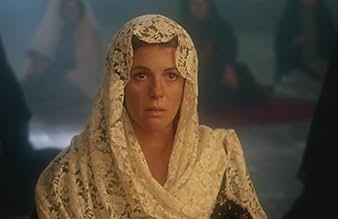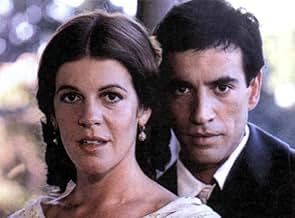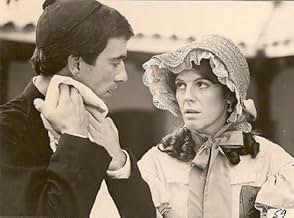NOTE IMDb
6,9/10
1,6 k
MA NOTE
Dans les années 1840 à Buenos Aires, en Argentine, une belle jeune mondaine nommée Camila tombe amoureuse de Ladislao, un prêtre. Après plusieurs tentatives pour combattre ses propres sentim... Tout lireDans les années 1840 à Buenos Aires, en Argentine, une belle jeune mondaine nommée Camila tombe amoureuse de Ladislao, un prêtre. Après plusieurs tentatives pour combattre ses propres sentiments, il succombe finalement à elle.Dans les années 1840 à Buenos Aires, en Argentine, une belle jeune mondaine nommée Camila tombe amoureuse de Ladislao, un prêtre. Après plusieurs tentatives pour combattre ses propres sentiments, il succombe finalement à elle.
- Réalisation
- Scénario
- Casting principal
- Nommé pour 1 Oscar
- 2 victoires et 2 nominations au total
Avis à la une
I would recommend this movie for a variety of reasons. Most importantly, it gives a clear impression of what life was like in Argentina at this time. The power that the government, Rosas, had over the people is mind boggling. The fact that a father could be brainwashed enough to choose the government over the life of his own daughter is sickening! This just illustrates the power and backwardness of Rosas' dictatorship. I also enjoyed this movie for the romantic aspect of the story. It kept you in suspense, while you routed for the couple's escape to happiness. The moving ending of the film leaves you with much to think about.
In 1982, the Argentine military government seized the Falkland Islands, also known as Las Islas Malvinas, from the British. The British deployed combat forces to the South Atlantic and recaptured the territory in a war that lasted ten and a half weeks. This led to the downfall of the Argentine military junta and a reversion to democracy, establishing conditions which in 1984 brought to the screen a true story that had been suppressed by political, religious, and/or cultural forces for nearly fourteen decades. It is one of the most popular movies in the history of Argentina, from among those produced by that nation.
Camila refers to Camila O'Gorman, and opens very briefly in her childhood with the arrival at her family's ranch of a stagecoach bearing her grandmother, who is to be placed under house arrest. Camila's father fully consents to the arrangement, siding with the authorities rather than with his mother, who is on the wrong side of contemporary political affairs. The opening then shifts forward to Buenos Aires, 1847. Camila, now a young woman of about 19, is closeted with and huddled over some newborn kittens she knows will earn her father's disapproval if he discovers them. In the late 1840s, Argentina is under the control of a dictator, General Rosas, and the federals. The unitarians, some in exile and others trying to stay under the radar (as it were), are the latent opposition.
The plot can be summarized simply: A socialite daughter from a wealthy family falls in love with a (celibate) Jesuit priest. It is not only taboo in a Catholic society, but is taboo in a Catholic society at the wrong place and the wrong time, and neither the federals nor the unitarians contribute positively to the outcome. As the kittens meet their fate and the opening credits conclude, we view a statement dedicating the movie: "In memory of Camila O'Gorman ." History, and director Maria Luisa Bemberg, are serious about the advisory, so be forewarned, and be aware also that the movie has an R rating. The film coloring is memorable, and Susu Pecoraro in the lead actress role gives a strong performance.
Camila refers to Camila O'Gorman, and opens very briefly in her childhood with the arrival at her family's ranch of a stagecoach bearing her grandmother, who is to be placed under house arrest. Camila's father fully consents to the arrangement, siding with the authorities rather than with his mother, who is on the wrong side of contemporary political affairs. The opening then shifts forward to Buenos Aires, 1847. Camila, now a young woman of about 19, is closeted with and huddled over some newborn kittens she knows will earn her father's disapproval if he discovers them. In the late 1840s, Argentina is under the control of a dictator, General Rosas, and the federals. The unitarians, some in exile and others trying to stay under the radar (as it were), are the latent opposition.
The plot can be summarized simply: A socialite daughter from a wealthy family falls in love with a (celibate) Jesuit priest. It is not only taboo in a Catholic society, but is taboo in a Catholic society at the wrong place and the wrong time, and neither the federals nor the unitarians contribute positively to the outcome. As the kittens meet their fate and the opening credits conclude, we view a statement dedicating the movie: "In memory of Camila O'Gorman ." History, and director Maria Luisa Bemberg, are serious about the advisory, so be forewarned, and be aware also that the movie has an R rating. The film coloring is memorable, and Susu Pecoraro in the lead actress role gives a strong performance.
This film is about a doomed relationship between the daughter of a rich fascist-type landowner in Argentina about 1830 or so (after the successful revolution against the Spanish). The new government, it seems, feels that the end justifies the means and repression is used to keep control of the fledgling nation.
Camila finds that she is not attracted to the macho rich suitors but instead finds herself drawn to the new Jesuit priest. Despite common sense and many obstacles, they run off together. What I found most interesting in the movie was the character of her father, who was instrumental in tracking them down and exacting punishment.
In many ways, the plot reminded me of The Thorn Bird mini-series combined with a fascist-like backdrop. A pretty good film overall. Be aware, however, of the nudity. It's NOT as much as you might expect in such a film but considering he's a priest, it's bound to offend some.
Camila finds that she is not attracted to the macho rich suitors but instead finds herself drawn to the new Jesuit priest. Despite common sense and many obstacles, they run off together. What I found most interesting in the movie was the character of her father, who was instrumental in tracking them down and exacting punishment.
In many ways, the plot reminded me of The Thorn Bird mini-series combined with a fascist-like backdrop. A pretty good film overall. Be aware, however, of the nudity. It's NOT as much as you might expect in such a film but considering he's a priest, it's bound to offend some.
10syt48-1
"Camila" takes place in Buenos Aires, Argentina (1847-1848) during the tyrannic rule of Governor Juan Manuel de Rosas. The film recounts the tragic true story of Camila O'Gorman, a 19 year old socialite, who falls madly in love and runs away with a young Jesuit Priest, Ladislao Gutierrez. For a few months they were able to live happily as man and wife in a small village near the border of Brazil where they worked as school teachers. Respected by all who knew them, and unaware of their real identity, Camila and Ladislao were eventually recognized by a priest and captured. Imprisoned and executed without a trial by Rosas' orders, their bodies were placed together in a double coffin. At the time of her death Camila was eight months pregnant (but, perhaps due to censorship the film alters that fact) and her execution, along with Ladislao's, prompted the downfall of Rosas' reign.
This is a story that goes beyond doomed love, but also focuses upon personal and political freedom. Susu Pecoraro (Camila), who bares a strong resemblance to the real Camila, and Imanol Arias (Ladislao) are magnificent. This film is a masterpiece!
This is a story that goes beyond doomed love, but also focuses upon personal and political freedom. Susu Pecoraro (Camila), who bares a strong resemblance to the real Camila, and Imanol Arias (Ladislao) are magnificent. This film is a masterpiece!
"Camila" is a love story set in Colonial Argentina. Camila is a young woman hungry for change and knowledge of the unknown. She meets Ladislao, a young priest whom with she immediately falls in love with. The two decide to escape in order to fulfill their desire for each other. They settle in a remote village but still must face the consequences of their decision. Directed by Maria Luisa Bemberg, "Camila" tells the story of a passionate woman who will fight for what she desires and is willing to sacrifice everything for it. The film is true to the times in which it is based and true to the characters it is based on. Rosas, the dictator at the time, is portrayed in a way that is also true to history. The director Bemberg is also a passionate woman and filmmaker who struggled with censorship in the making of this film, but prevailed. Although it is based on real people, some of the characters are shaped in order to benefit the ideals of the director, but a good film nonetheless. I also recommend "I, the Worst of All" by the same director.
Le saviez-vous
- AnecdotesThis is the second Argentine film to be nominated for an Academy Award for the 'Best Foreign Language Film' in 1985.
- Citations
Ladislao Gutiérrez: I'm listening, Camila. Talk.
Camila O'Gorman: I'm dying of love, father.
- ConnexionsReferenced in There's Nothing Out There (1991)
Meilleurs choix
Connectez-vous pour évaluer et suivre la liste de favoris afin de recevoir des recommandations personnalisées
- How long is Camila?Alimenté par Alexa
Détails
Contribuer à cette page
Suggérer une modification ou ajouter du contenu manquant






























